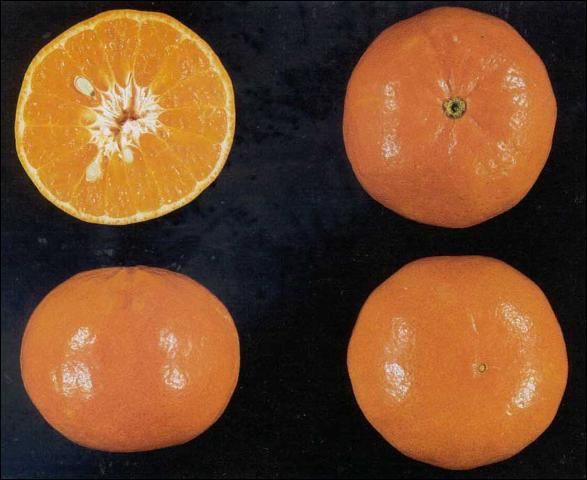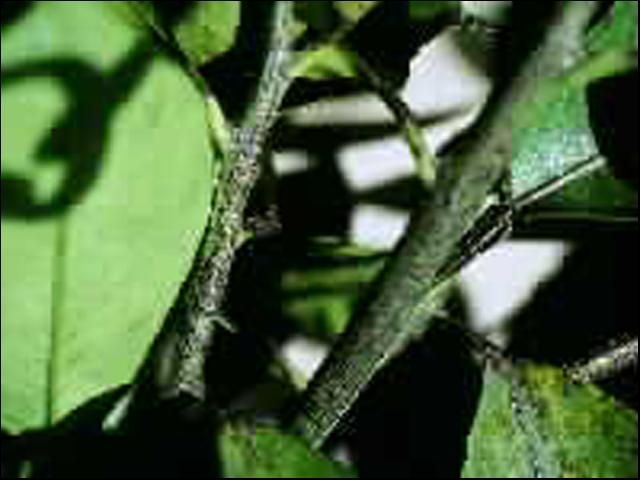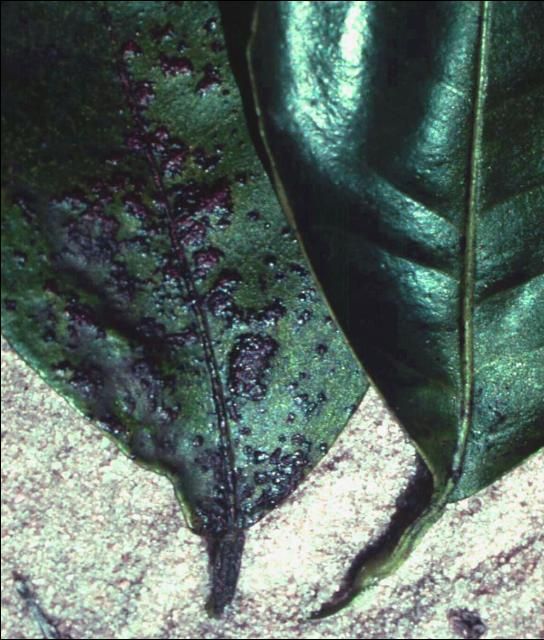Sunburst (Figure 1) is the most widely grown commercial early Florida tangerine. It is a cross between the two citrus hybrids Robinson and Osceola. This cross was made in 1961 and was released for commercial use in 1979 by C. J. Hearn of the United States Department of Agriculture in Orlando.

Credit: UF/IFAS CREC
Fruit Characteristics
The fruit is medium in size, about 2½ - 3 inches in diameter. Fruit shape is oblate and is flattened at the stem end and has a depressed navel. The rind is thin, smooth, and somewhat easily removed. Fruit segments number from 11 to 14 and have a somewhat hollow central axis. Seed numbers will vary depending upon cross-pollination but will generally average between 10 to 20 seeds per fruit. When the seeds are cut open, they will have a pale green color inside. The peel is an outstanding dark orange color with excellent internal juice color.
In most years the fruit will reach maturity by mid-November and will remain acceptable through late December. When the fruit is harvested care must be taken as in some cases the fruit will plug, tearing the stem end out instead of separating from the stem evenly. For this reason, the grower might consider clipping the fruit from the tree.
Tree Characteristics
Sunburst trees have dark-green foliage, moderately vigorous, thornless, up-right, and spreading shape. They are tolerant of snow scale, moderately cold hardy and have resistance to scab.
Trees have been produced on many of the standard rootstocks of Carrizo citrange, sour orange, Swingle citrumelo and Cleopatra mandarin and have all produced acceptable fruit quality and yield.
Cultivation
Cultural practices for Sunburst are similar to most of the other citrus cultivars in that they will grow throughout the citrus producing areas. There are several items for special attention, and they are as follows:
- This cultivar is self-incompatible and will produce poorly when planted in solid blocks. To achieve maximum fruit set an adequate number and arrangement of pollenizer trees should be located within close proximity of the Sunburst trees. Temple, Orlando, Nova, and Minneola are rated very good with Robinson and Fallglo rated good as pollenizers. Cross pollination increases seed numbers. Fruit with high seed numbers are less desirable in the fresh fruit market.
- In years of heavy fruit set, thinning should be considered as a method to increase fruit size.
- Sunburst trees may exhibit severe brownish leaf and stem blistering (Figure 2) from excessive Texas citrus mite and citrus rust mite feeding. The grower must monitor not only the fruit but the leaves as well because mite populations will, in many cases, reach higher damaging numbers on the leaves before causing damage to the fruit. The blistering on the leaves and stem is an apparent latent response to earlier mite feeding. Blistering will be greatest on the petiole and along the midrib vein. Mite feeding (Figure 3) on leaves late in the fall has caused chlorotic areas to form, resulting in premature leaf drop. For more information on mites see the Citrus Mite Pests topic page.
- Fruit which has not started to show partial color change has a higher fruit decay after degreening. Fruit should have at least partial to full color change prior to harvest to reduce degreening time thereby resulting in fewer decay problems after harvest.
- Popularity of Sunburst has declined in recent years as it is highly susceptible to HLB or citrus greening.

Credit: UF/IFAS CREC

Credit: UF/IFAS CREC
More Information
Florida Citrus Production Guide
Additional information can be found on Sunburst in the following publications:
Achor, D.S., L.G. Albrigo and C.W. McCoy. 1991. "Developmental Anatomy of Lesions on 'Sunburst' Mandarin Leaves Initiated by Citrus Rust Mite Feeding." J. Amer. Soc. Hort. Sci. 116(4):663–668.
Albrigo, L.G., C.W. McCoy and D.P.H. Tucker. 1987. "Observations of Cultural Problems with 'Sunburst' Mandarin." Proc. Fla. State Hort. Soc. 100:115–118.
Futch, S.H. and LK Jackson, Cross-Pollination Planting Plants UF IFAS HS170. https://edis.ifas.ufl.edu/publication/CH070
Futch, S.H. and LK Jackson, Pollination of Citrus Hybrids UF IFAS HS182. https://edis.ifas.ufl.edu/publication/CH082
Hatton, T., J. Hearn and J. Smoot. 1986. "Degreening and Storage of 'Sunburst' Citrus Hybrid Fruit." Proc. Fla. Hort. Soc. 99:127–128.
Hearn, C.J. 1979. "Performance of 'Sunburst', A New Citrus Hybrid." Proc. Fla. State Hort. Soc. 92:1–3.
Rust Mites, Spider Mites, and other Phytophagous Mites UF IFAS CG002. https://edis.ifas.ufl.edu/publication/CG002
Saunt, James. 2000. Citrus Varieties of the World. Sinclair International Limited, Norwich, England. p. 73.